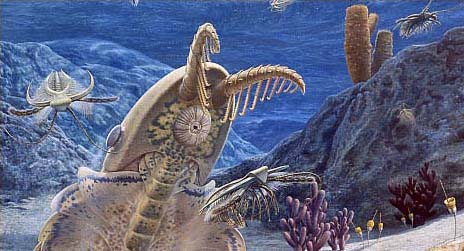 |
 |
 |
 |
 |
Produced
by the Population Genetics and Evolution class, Furman University |
||||
 |
 |
 |
 |
 |
Produced
by the Population Genetics and Evolution class, Furman University |
||||
 |
The
Cambrian: Hallucigenia |
 |
||
| Hallucigenia
is an extinct organism that existed during the Cambrian Period approximately
530 million years ago (Levinton 2008). Its appearance has been a matter
of debate, but the current model is of an organism roughly three centimeters
long with seven rows of spikes on its back. Ther current interpretation
is attributed to Lars Ramskold who suggested that the original image of
Hallucigenia, with spines as the legs and the tentacles on the
dorsal side, was upside down. The reorientation places the spines on the
back, where they could have been used to ward off predators. In this interpretation,
the seven pairs of clawed tentacles were used for walking on the sea floor.
They were believed to have been scavengers (Smithsonian 2010). The new
information allowed scientists to place the organism in the phylum Onychophora,
which includes modern day velvet worms (Chronicles of Canadian Paleontology
2007). Page by Iggy Gaska |
 |
| Diagram of Hallucigenia by Ramskold, from: The Smithsonian Institution. | |
|
Levington S. 2008. The Cambrian Explosion: How do we use the evidence? Bioscience 58: 855-864.No.9 Ludvigsen R, Chatterton B. 2008. The Hallucigenia flip. Past Lives: Chronicles of Canadian Paleontology. Geological Survey of Canada. Accessed December 27, 2007. The Smithsonian Institution. 2010. Burgess Shale: Hallucigenia sparsa. Accessed January 31, 2010. |